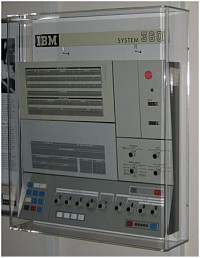Computer Science
Computing History Displays: Fourth Floor - IBM 360 Model 30
The model 30, a front-panel of which we have on display, was the "bottom-end" model in the original System/360 announcement. Its designers went to great lengths to minimize the amount of hardware in the processor. Although the System/360 was a 32-bit architecture the Model 30 was an 8-bit design, with 8-bit internal registers, functional units, and data paths. The registers required by the 360 architecture were held in a section of the main memory not addressable by 360 instructions. The machine operated with a clock of 1.3 MHz. The maximum core memory size was 64 Kbytes. Because of the restriction to 8-bits the machine was very slow - 0.3mSec to add. Interestingly, the model-30 processor was similar in power to the single-chip Intel 8080 processor used in the first PCs just 10 years later.
The model 30 was designed so that it could emulate efficiently the very-popular IBM 1401 computer, providing greater performance than the original. Many of the early model-30s were operated as 1401s. The 1401 instruction set architecture was very different from the 360 - memory to memory instructions with variable-length data. The model-30 micro-machine was thus particularly flexible. The micro-storage known as CCROS (card-capacitor read only storage) had 60-bit words. It was a read-only memory constructed as an array with bits represented by capacitors. The capacitors were constructed with one plate on a glass substrate and the other on a special plastic punch card with printed wires. The memory was programmed by punching out the capacitor plates for zeroes, using a standard card punch. Each card held twelve words of 60 bits, running long-ways along the card. There were about 4k words of microcode, or about 340 cards. Being that the read-only memory was very easy to change, there were also research projects to modify the machine for other purposes.
This particular model-30, serial number 536204/5, was leased by DIERCOMP to Drug Houses, Australia and subsequently used by Colgate-Palmolive. At the end of its useful life it was "junked" but not destroyed. A group of Auckland University students in the New Zealand Microcomputer Club found the machine in 1982. One, Lawrence Wilkinson, rented an office in Custom Street, re-installed the computer and eventually managed to get it working. Lawrence's efforts have become an urban legend, described here .
He eventually stopped paying the rent and abandoned the machine where it was. Staff at our Computer Science department heard that the machine was going to finally be destroyed in the mid-90s in preparation for the Britomart development and we saved some of its components at that time.





